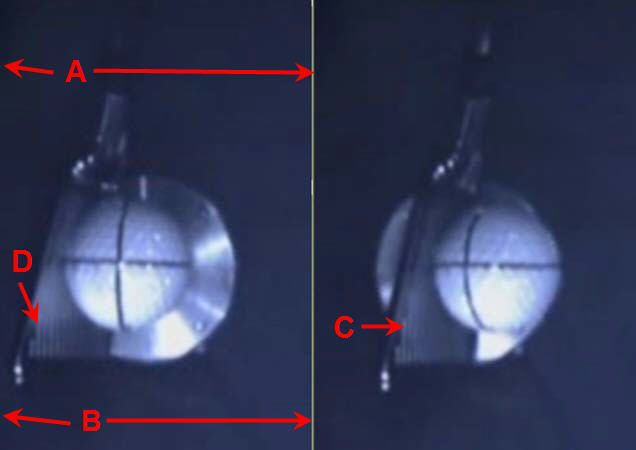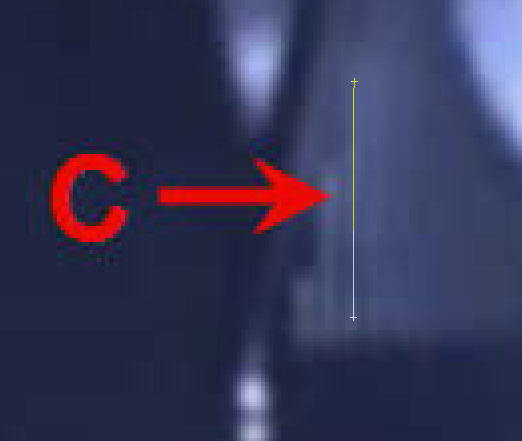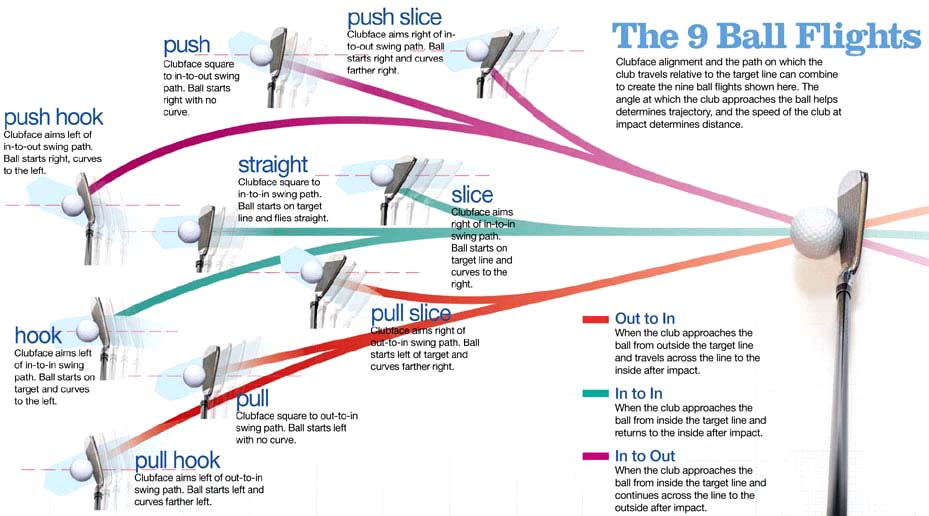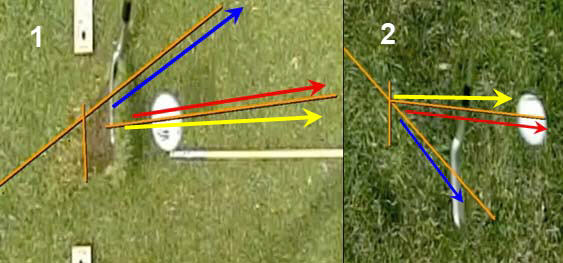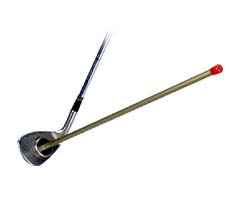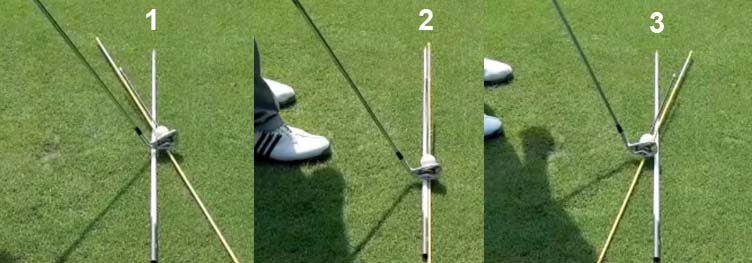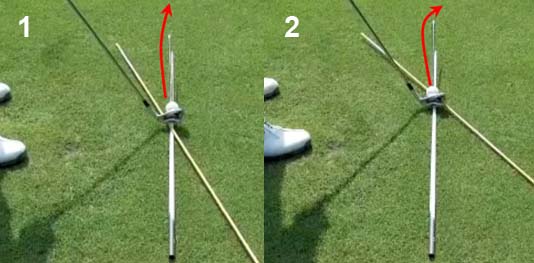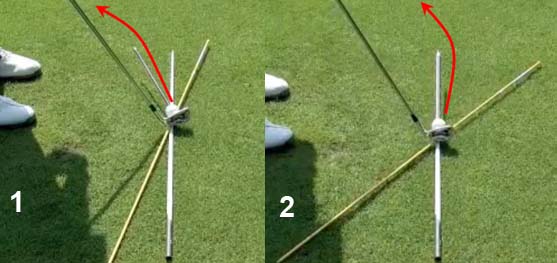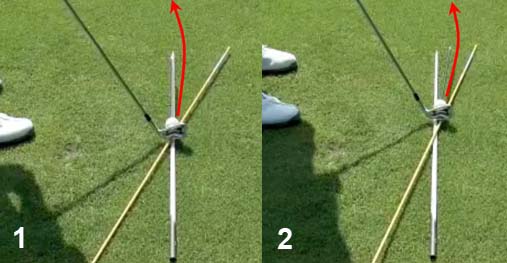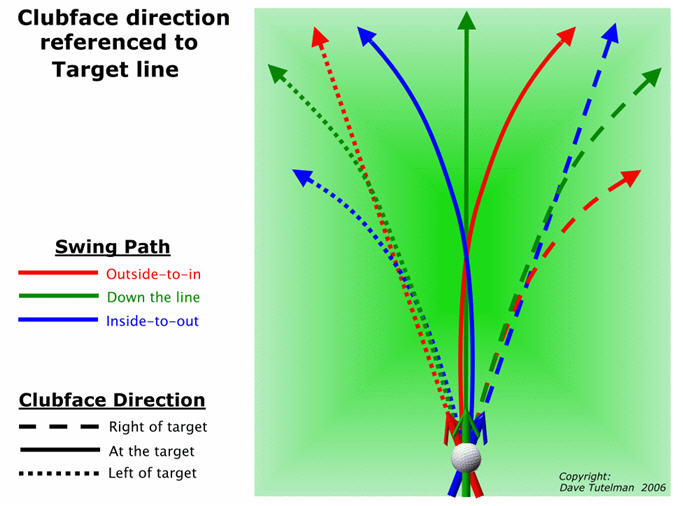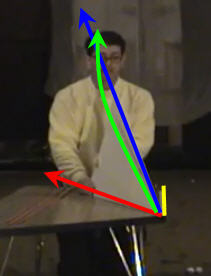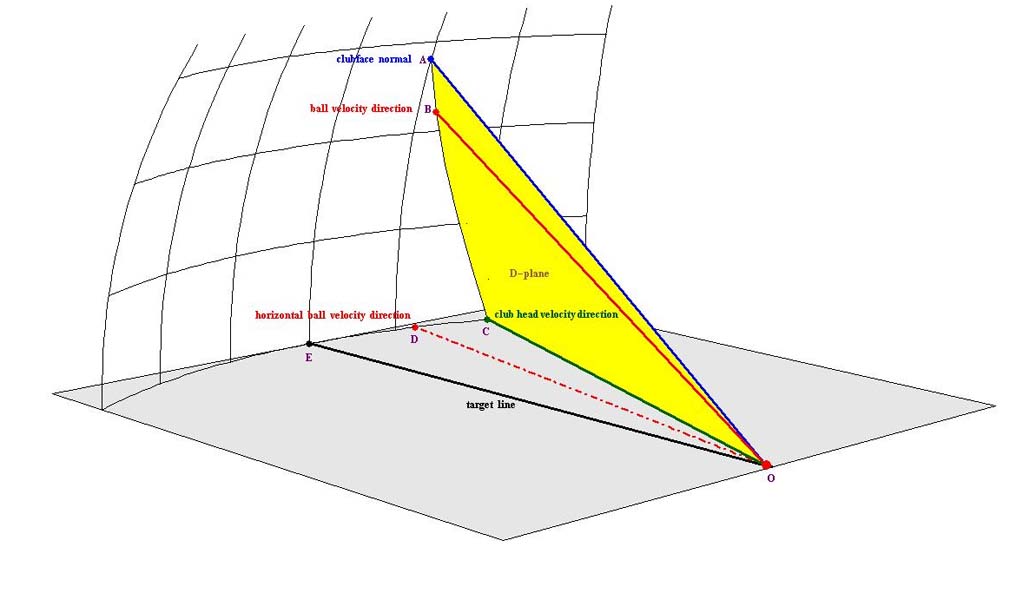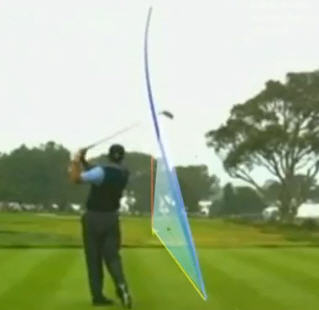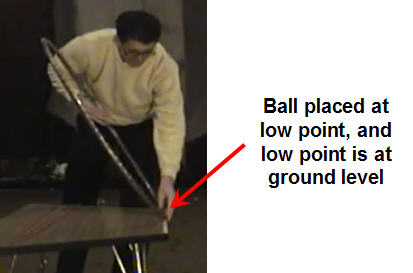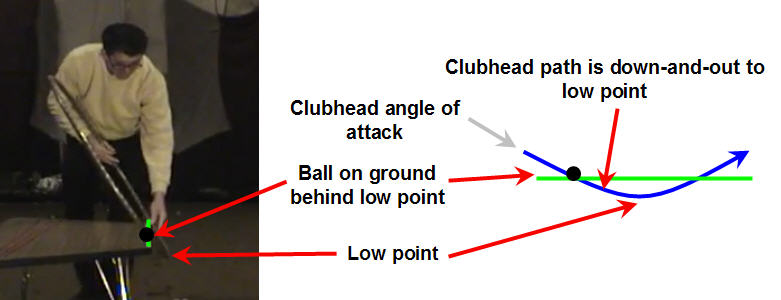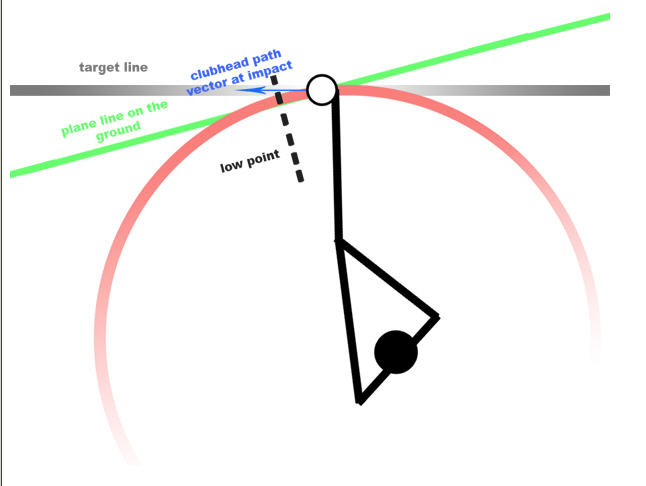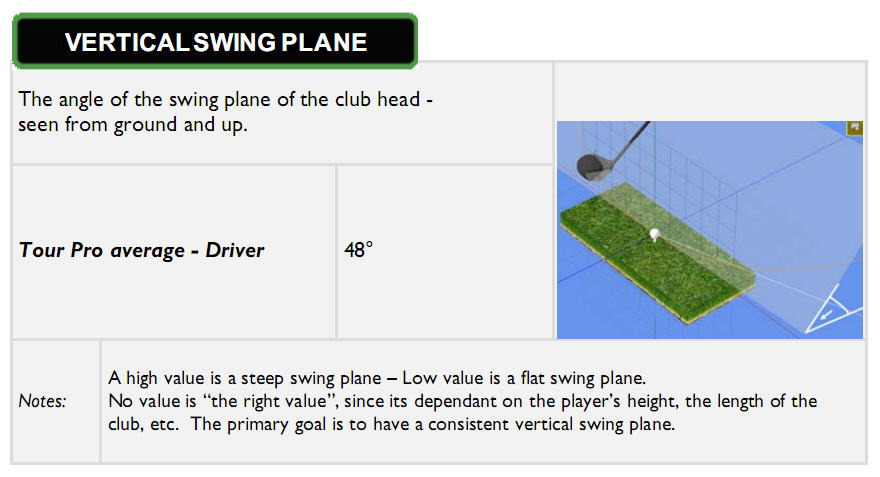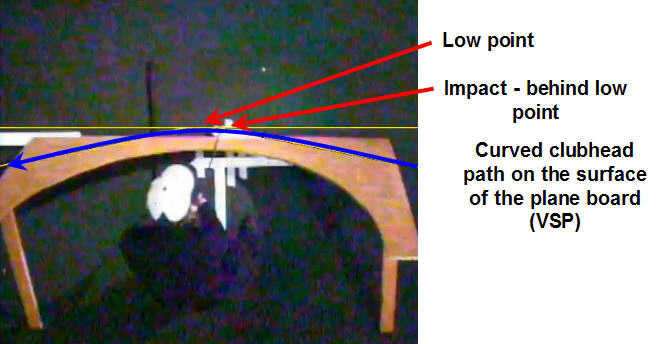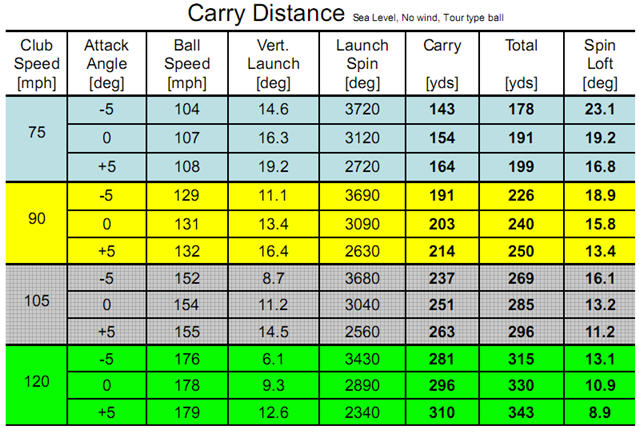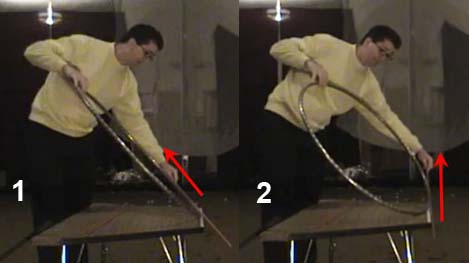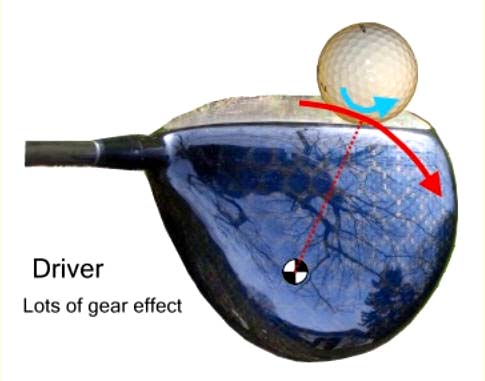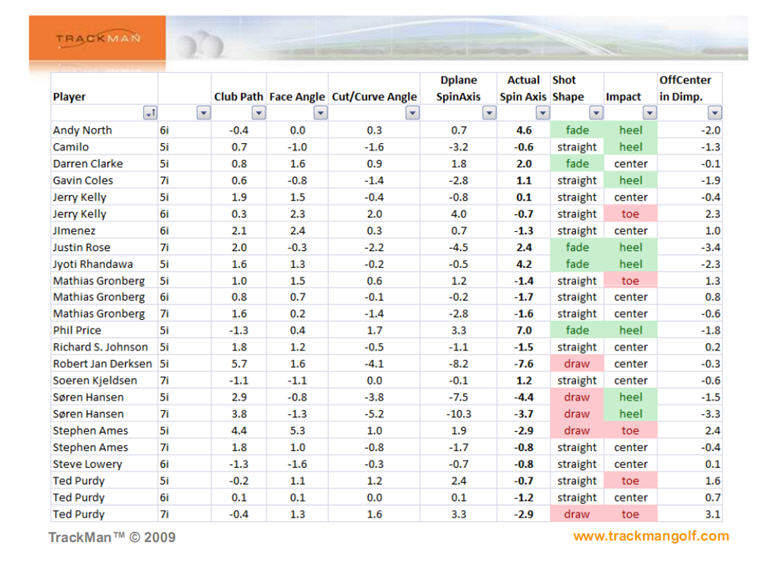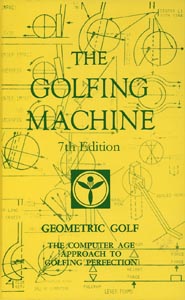Be Your Own Teacher: The New Ball Flight Laws
Introduction
This review paper is devoted to a discussion of the ball flight laws – a discussion of the club factors that affect a golf ball’s flight pattern in space. I believe that a golfer can greatly benefit if he has in-depth understanding of the factors that affect ball flight – in particular, the influence of clubface orientation and clubhead path on ball flight. Ball flight laws have great relevance for golfers who deliberately want to create a certain ball flight pattern (eg. push-draw or pull-fade ball flight pattern) or who want to understand why they have a non-deliberate predisposition to a particularly undesirable ball flight pattern (eg. push-sliced shots or snap-hook shots). One cannot hope to fruitfully change one’s swing if one doesn’t correctly identify the primary problems causing an undesirable ball flight pattern.
Our understanding of factors that affect ball flight patterns has changed in the last decade, and the major factor allowing for a greater understanding of the “new” ball flight laws has been the development of the Trackman machine [1]. The Trackman machine is a radar device that not only tracks ball flight and clubhead/ball speed – it also measures the movement of the clubhead in space through the impact zone and the clubface orientation at impact. The device is so accurate that it can detect changes in clubhead path and /or clubface orientation of ~1 degree, and that ability has allowed researchers to more accurately determine the effect of changes in clubhead path and clubface orientation on ball flight. The Trackman device has demonstrated that the “old” ball flight laws are wrong, and it allows golfers to more accurately achieve their desired ball flight pattern by making appropriate changes to their clubhead path and clubface orientation at impact.
I will start off by discussing the “old” ball flight laws before discussing the “new” ball flight laws. However, as a preliminary introduction to the discussion of the “old” versus the “new” ball flight laws, consider how a golfer hits a straight shot.
Homer Kelley discussed the three major factors that allow a golfer to hit the ball straight in his TGM book [2]. Homer Kelley stated that a golfer needs to control the clubshaft, the clubhead and the clubface. A golfer needs to create an in-to-square-to-in clubhead path through the impact zone, and a golfer will usually find it easier to achieve that goal if he stands square to the ball-target line (feet and body parallel to the ball-target line) and if he traces a straight plane line (SPL = ball-target line). If a golfer traces a SPL (as described in my review paper on How to Hit the Ball Straight – the Essential Elements), then he will create an “on-plane” clubshaft movement in space, and an in-to-square-to-in clubhead path that is perfectly symmetrical relative to the ball-target line. The second goal that a golfer needs to achieve is clubhead timing, so that the clubhead reaches the ball along a clubhead path that is fractionally in-to-out (relative to the ball-target line) at near-impact and square to the ball-target line at the exact moment of ball-clubface separation. The third factor is clubface orientation. The clubface must also be square to the ball-target line at impact. If the clubhead path is directed straight at the target at impact (presuming a clubhead attack angle of zero degrees) and if the clubface also faces the target at impact, then the ball will go straight. However, there are two points where Homer Kelley was wrong regarding the the factors needed to produce a straight ball flight.
Homer Kelley stated that a golfer should aim his clubhead at the inner quadrant of the ball, with the idea of hitting the ball about 1-2 dimples inside-of-the-center of the back of the ball. Homer Kelley believed that the clubface would be constantly closing by a few degrees while it remained in contact with the ball (during the 1/4,000th of a second time period of clubface-ball contact time) and if a golfer wanted the clubface to be facing the target at the exact moment of clubface-ball separation, then he should ensure that it is a few degrees open at the exact moment of first ball contact. However, the Trackman device has demonstrated that the clubface orientation only changes by ~1 degree during the 1/4,000th of a second time period of clubface-ball contact in a skilled golfer’s swing, and this fact has been confirmed with high speed cameras.
Consider two high speed videos of golf ball/clubface contact during impact.
http://www.youtube.com/watch?v=2Y57pw_iWlk
http://www.youtube.com/watch?v=mEp0yAj7IYQ
I examined the second swing video in detail using my V1 Home swing analyser program, and I captured the following capture images from that swing video.
Clubface-ball contact – capture images from a swing video
I used very large capture images of the swing video which I then imported into Photoshop, and I then used Photoshop’s angle measuring tool to measure each of the first 4 white lines (along the top edge of the clubface). Image 1 shows the exact moment of first clubface-ball contact, and image 2 shows the exact moment of clubface-ball separation. The clubface has traveled a distance of ~0.6″ during this time period.
I first verified that the left edge of the image was vertical (A and B on each left side) and I got figures of 90.2 degrees for the left edge of image 1 (between A and B) and 90.3 degrees for the left edge of image 2 (between A and B).
I then measured the angle of each of the top 4 white lines – which are clearly visible (eg. point C and D each point at the second white line). All my readings were within 0.5 degrees of 90 degrees.
Magnified image of my measuring technique
The white line is Photoshop’s measuring tool line overlying the third white line. It gave a measurement of 89.7 degrees.These crude measurements reinforce my belief that the Trackman’s average measurement of ~1 degree clubface angle change during the time period of clubface-ball contact is probably accurate, and it demonstrates the fact that the clubface orientation doesn’t significantly change during the short time period of clubface-ball contact in a skilled golfer’s swing.
An important coincidental finding of this “fact” is that angled hinging cannot produce a different ball flight than horizontal hinging – due to a significant variation in clubface orientation during the short time period of clubface-ball contact. I previously believed that the clubface was closing more (during the time period of clubface-ball contact) if a golfer used horizontal hinging (rather than angled hinging), but I now believe that there is no scientific evidence to support that scientifically-unsupported belief. Hinging actions occur during the followthrough period, and the clubface is traveling a distance of ~18″ between impact and the end of the followthrough. The impact clubface-ball contact interval only involves a travel distance of ~ 0.7″ and I have unearthed no evidence that the clubface is closing more during this short impact interval time period if a golfer uses horizontal hinging (compared to angled hinging).
The “old” ball flight laws
Here is a detailed diagram depicting the old 9 ball flight laws.
Old ball flight laws
According to the “old” ball flight laws there are three clubhead path patterns – out-to-in; in-to-square-to-in and in-to-out – and the ball starts off in the direction of these three clubhead paths. Then, according to the “old” ball flight laws, the ball flight will vary and the ball will curve away from the starting path if the clubface is either open, or closed, to the clubhead path.
Starting at the top, the “old” ball flight law predicts that if the clubface is oriented square to an in-to-out clubhead path (purple color) then the result will be a straight push. If the clubhead is open to the in-to-out clubhead path, then the result will be a push slice. If the clubface is closed to the in-to-out clubhead path, then the result will be a push hook.
If the clubface is square to an in-to-square-to-in clubhead path (green color), then the ball will go straight. If the clubface is open to an in-to-square-to-in clubhead path, then the result will be a slice. If the clubface is closed to the in-to-square-to-in clubhead path, then the result will be a hook.
If the clubface is square to an out-to-in clubhead path (red color), then the result will be a pull. If the clubface is open to the out-to-in clubhead path, then the result will be a pull-slice. If the clubface is closed to the out-to-in clubhead path, then the result will be a pull hook.
In summary, the “old” ball flight laws predicted that a golf ball will start off in the direction of the clubhead path, and that it will then only deviate leftwards (or rightwards) if the clubface is closed (or open) to the clubhead path.
The “old” ball flight laws are still being taught by the US Golf Schools Organization – see http://www.ussog.com/aboutus/mr_teach_com/lessons/Ball-Flight-Laws.asp
However, evidence from “reality” and the Trackman machine has demonstrated that the “old” ball flight laws are wrong. The true reality is that the ball will primarily start off in the direction of the clubface, and that it will only deviate from that initial direction if the clubhead path is directed left-or-right of the clubface orientation at impact. Let’s consider the “new” ball flight laws.
The “new” ball flight laws
The “new” ball flight laws are based on the “fact” that the ball’s flight pattern is primarily dependent on the clubface orientation at impact, and that approximately 85% of the ball’s initial flight direction is determined by the clubface orientation while only 15% of the initial flight direction is dependent on the clubhead path at impact.
Direction of initial ball flight – from reference number [3]
A swing video that most convincingly demonstrates this point was made by Golf Evolution – http://www.youtube.com/watch#!v=eEHiY5iv5u4
In that video, the golfer made two swings – where the clubhead path was extremely in-to-out and extremely out-to-in, while the clubface always faced targetwards. In both cases, the ball’s initial flight direction was about 80% in the direction of the clubface’s orientation.
Initial ball flight after impact – capture images from the swing video
The yellow arrow depicts the clubface orientation at impact. The blue arrow depicts the clubhead path at impact – in image 1 it is extremely out-to-in, and in image 2 it is extremely in-to-out.
The red arrow depicts the initial ball flight direction – and it is roughly 80% in the direction of the yellow arrow (clubface orientation at impact) relative to the blue arrow (clubhead path at impact).
The best method of assessing the clubface orientation is to use a magnetic lie angle tool.
Lie angle tool
The lie angle tool consists of a rod that is attached to a magnetic disc, so that the rod is perpendicular to the magnetic disc base. If the magnetic disc base is placed on the clubface, the rod gives one a 3-D perception of the clubface’s directional orientation.
John Dunigan uses a lie angle tool in his swing video demonstrating the “new” ball flight laws – http://www.youtube.com/watch?v=Wnq6TiXw7wU
John Dunigan does an excellent job explaining the “new” ball flight laws. However, he makes one mistake by claiming that the ball leaves the clubface at takeoff in the direction that the clubface is oriented, when the initial ball flight is only 80-85% in the direction of the clubface orientation at impact (relative to the clubhead path at impact) if there is a divergence between the clubhead path at impact and the clubface orientation at impact. I will discuss some of his video presentation examples – and in my explanations I am going to presume that the clubhead attack angle is always zero and that the ball is always hit on the sweetspot.
Straight shots – capture images from the Dunigan swing video
Image 1 shows a straight pulled shot. The white rod represents the ball-target line, and the yellow rod represents the clubhead path at impact. Note that the clubface orientation (lie angle rod) is pointing in the same direction as the leftwards-directed clubhead path, and that will produce a straight pulled shot to the left.
Image 2 shows a straight shot at the target. The clubhead path is directed along the ball-target line, and the clubface orientation (lie angle rod) is also directed along the ball-target line, and that will result in an initial ball flight that is directed straight towards the target. If the clubhead path and clubface orientation are pointing in the same direction, then the ball will not acquire any side-spin that will cause the ball to either slice to the right, or draw to the left.
Image 3 shows a straight pushed shot. The clubhead path is directed right of the ball-target line, and the clubface orientation (lie angle rod) points in the same direction. The initial ball flight will be straight to the right of the target, and this will produce a straight pushed shot. If the clubhead path and clubface orientation are pointing in the same direction, then the ball will not acquire any side-spin that will cause the ball to either slice to the right, or draw to the left.
Now, let’s consider an example where there is a certain degree of divergence between the clubhead path at impact and the clubface orientation at impact.
Pull slice ball flight – capture images from the Dunigan video
Image 1 shows a clubhead path that is directed left of the ball-target line at impact, and a clubface orientation that is directed at the target. The red arrow depicts the initial ball flight direction and the arrowhead end depicts the later direction of ball flight curvacture. The ball will start off in a direction that is just left of the ball-target line (~85% in the direction of the clubface orientation relative to the clubhead path). The ball will slice to the right later in its flight, and that is due to the presence of slice side-spin (due to the fact that the clubface is open to the clubhead path at impact).
Image 2 shows a clubhead path at impact that is directed even more left-of-the-ball-target line, while the clubface still points at the target. The ball will still start off just left of the ball-target line (~85% in the direction of the clubface orientation relative to the clubhead path), but it will slice even more to the right later in its ball flight – due to the presence of a greater amount of slice side-spin (due to the greater degree of divergence between the clubface orientation and the clubhead path at impact).
This presentation demonstrates a common swing fault that is frequently present in beginner golfers, who have a propensity to hit a pull-sliced shot (most often due to an OTT move). They notice that their ball starts off just to the left-of-the-center of the fairway and that it then slices off to the right, and they think that they need to correct the problem by swinging more to the left. However, when they swing more to the left (thereby increasing the degree of divergence between the clubhead path and the clubface orientation at impact), they produce a greater degree of slice-spin, and the ball slices even more to the right. If those beginner golfers understood this “new” ball flight law explanation, then they would realise that they need to fix their OTT move and their out-to-in clubhead path problem.
Consider another example – where a golfer hits a snap-hook shot.
Snap hook shot – capture images from the Dunigan swing video
Image 1 shows a snap hook shot – which can occur even though the clubhead path is in-to-out. The primary cause of the problem is a closed clubface – that is closed to the clubhead path (and also closed to the ball-target line). The ball starts off left of the ball-target line, and then hooks violently to the left due to the presence of a large amount of draw spin (due to the large degree of divergence between the clubface orientation and clubhead path at impact). If a golfer thinks that he needs to swing far more to the right to correct his snap-hook problem, then he is making a cardinal mistake due to the fact that he doesn’t understand the “new” ball flight laws.
Image 2 shows a clubhead path that is even more to the right with a clubface orientation that is directed along the ball-target line. Note that the ball will start off in a take-off direction that is directed slightly to the right of the ball-target line, but it will still hook violently to the left. It may no longer be a snap-hook (where the ball starts left and goes further left), but the golfer will still have a severe hook problem due to the fact that the clubface is markedly closed to the clubhead path. This golfer should realise that his primary problem is a closed clubface at impact problem, and not a clubhead swing path problem. This golfer primarily needs to correct his closed clubface problem, and he should not primarily think of altering his clubhead swing path through the impact zone. He should think of all possible causes of a closed clubface at impact eg. closed clubface adopted at address, flipping the clubhead through impact, weak grip with excessive forearm rotation through impact.
Consider a third example – of a golfer who deliberately wants to hit a slight draw, where the ball starts slightly to the right and draws back to the center of the fairway (a point along the ball-target line).
Push-draw shot – capture images from the Dunigan swing video
Image 1 shows the clubface orientation and clubhead path that a golfer would likely adopt if he was indoctrinated by the “old” ball flight laws – the clubface (and lie angle tool) would be directed along the ball-target line and the clubhead path would be in-to-out through the impact zone. To draw a ball towards a target that is along the ball-target line, a golfer would be instructed to aim his clubface at the target (target point “somewhere” along the ball-target line where he wanted the ball to end) and he would then be instructed to swing his clubhead in-to-out to produce draw spin. However, that combination-choice would not produce his desired result! The ball would actually start just to the right of the ball-target line, and then draw more leftwards (to the left-of-the-target) due to the presence of draw spin (due to the fact that the clubface is closed to the clubhead path).
To hit a controlled push-draw shot, where the ball starts off to the right and then draws back to the ball-target line (back to the center) later in its ball flight, a golfer needs to choose a clubhead path that is to the right-of-the ball-target line, and a clubface orientation that is also to the right-of-the-ball-target line, but where the clubface is slightly closed to the clubhead path – see image 2. Note that the ball starts off to the right (85% in the direction of the clubface orientation relative to the clubhead path) and draws back to the center due to the presence of draw spin (due to the fact that the clubface is closed relative to the clubhead path – even though it is open relative to the ball-target line). A good combination would be a clubhead path that is 6 degrees right-of-the-ball-target line, and a clubface orientation that is 3 degrees right-of-the-ball-target line (50% of the clubhead path). The same principle would apply to a pull-fade shot, where the clubhead path should be approximately 6 degrees left-of-the ball-target line, and the clubface orientation approximately 3 degrees closed to the ball-target line. That combination would produce a ball flight where the ball starts off just to the left-of the ball-target line, and fades back to the center (ball-target line) later in its ball flight.
Finally, consider the ball flight control method a golfer should use to bypass an obstruction (eg. tree alongside the fairway).
Ball flight predicament
Consider the predicament of the golfer in image 1. His ball has landed at point X – just off the right side of the fairway, about 180 yards from the green, which is surrounded on the left-and-right by two bunkers. There is a large tree (colored in dark green) about 40 yards in front of him obstructing his view of the center of the green and the hole, which is in the middle of the green. The tree is too high for him to consider the optional choice of hitting a straight shot over the top of the tree. There is a lake (colored in blue) on the right side of the rough and alongside the right side of the right bunker.
What can the golfer do to get the ball to land on the green near the hole? Image 2 shows that he has two ball flight options – he can either try to hit a pull-slice shot (yellow curved arrow) or he can try to hit a push-draw shot (orange curved arrow). The major problem associated with trying to hit a push-draw shot is that it is a very risky endeavour, because of the presence of the lake on the right side – he could easily land in the lake if he doesn’t successfully draw the ball enough. So, his best option is to try and hit a pull-slice shot. At the worst, if he doesn’t curve the ball back enough towards the center, it will either land in the bunker to the left of the green or in the left rough.
How should he execute this pull-slice shot?
Image 3 shows the approach recommended by the “old” ball flight laws. The clubface (short black line) should be aimed towards the center of the green (orange arrow) and his clubhead path should be directed left of the tree (yellow arrow). Theoretically, according to the tenets of the “old” ball flight laws, the ball should start along the direction of the clubhead path, and skirt the tree, before slicing to the right (secondary to the presence of slice spin due to the fact that the clubface is open to his clubhead path). However, that “imagined” ball flight will not happen in “reality” if he adopts that particular choice of clubface orientation and clubhead path. Image 4 shows what will happen in “reality”. The ball will start off just to the left of the clubface orientation (85% in the direction of the clubface orientation relative to the clubhead path) and curve to the right (red dotted arrow) into the tree.
The correct approach should follow the tenets of the “new” ball flight laws – see image 5. The clubface (short black line) should be angled to the left of the tree (orange arrow). The clubhead path should be directed even further left (yellow arrow). If the swing is executed correctly, then the ball will start off 85% in the direction of the clubface orientation and curve to the right (due to the fact that the clubface is open to the clubhead path). The ball should then follow the red dotted arrow path to the center of the green. The golfer needs to ensure that the degree of divergence between the clubhead path angle and the clubface orientation angle is appropriate – so that the ball acquires the “correct” amount of slice spin in order that it can curve rightwards towards the center of the green. If the ball is 40 yards from the tree, rather than 80 yards from the tree, then the golfer will need to curve the ball more to the right. To acquire a greater amount of slice spin, he needs to increase the magnitude of the divergent angle between the clubhead path and the clubface orientation – while keeping the clubface pointing just to the left of the tree. In other words, he will have to swing his club more leftwards if he wants to produce a greater degree of slice spin. It is only through repeated practice that a golfer can learn how to vary the magnitude of the divergent angle between the clubface orientation and the clubhead path to produce a certain finite amount of slice spin that is optimal for this particular ball flight predicament.
In summary, the fundamental principle of the “new” ball flight laws is that the ball starts off ~85% in the direction of the clubface orientation if there is a divergent angle between the clubface orientation and the clubhead path, and the ball will curve away from the clubhead path. If the clubface is closed to the clubhead path, then the ball will curve to the left (draw); and if the clubface is open to the clubhead path, then the ball will curve to the right (slice).
Consider a digram showing the “new” ball flight laws.
Diagram produced by David Tutelman – reference number [3]
I will start off with the three central ball flights – solid lines. The solid green line ball flight will be straight towards the target, and it will occur if the clubface is directed at the target and the clubhead path is down the line (directed at the target). The solid blue line ball flight will occur if the clubface is directed at the target, but the clubhead path is in-to-out. The ball will start off just to the right of the target, and curve leftwards to a degree that is dependent on the magnitude of the divergent angle between the clubface orientation and the clubhead path. The red solid line ball flight will occur if the clubface is directed at the target, but the clubhead path is out-to-in. The ball will start off just to the left of the target, and curve rightwards to a degree that is dependent on the magnitude of the divergent angle between the clubface orientation and the clubhead path.
Consider the three dotted ball flight patterns on the left. The red dotted line ball flight represents a straight pulled shot, and it will occur if both the clubface orientation and clubhead path are both directed leftwards to the same degree. The green dotted line ball flight will occur if the clubface orientation is left of the target, but the clubhead path is down the line (directed at the target). The ball will start off just to the right of the clubface orientation and curve away from the clubhead path to a degree that is dependent on the magnitude of the divergent angle between the clubface orientation and the clubhead path. The blue dotted line ball flight will occur if the clubface orientation is left of the target, but the clubhead path is in-to-out (directed right of the target). The ball will start off just to the right of the clubface orientation and curve away to the left to a greater degree – because of the large divergent angle between the clubface orientation and the in-to-out clubhead path.
Consider the three dashed ball flight patterns on the right. The blue dashed line ball flight represents a straight pushed shot, and it will occur if both the clubface orientation and the clubhead path are both directed rightwards to the same degree. The green dashed line ball flight will occur if the clubface orientation is right of the target, but the clubhead path is down the line (directed at the target). The ball will start off just to the left of the clubface orientation and curve away to the right, away from the clubhead path, to a degree that is dependent on the magnitude of the divergent angle between the clubface orientation and the clubhead path. The red dashed line ball flight will occur if the clubface orientation is right of the target, but the clubhead path is out-to-in (directed left of the target). The ball will start off just to the left of the clubface orientation, and curve away to the right to a greater degree – because of the large divergent angle between the clubface orientation and the clubhead path.
The D-plane
The D-plane concept is merely a conceptual method of translating the “new” ball flight laws into a 3-D dimensional mental image. In the previous section, I described how the clubface orientation can be different to the clubhead path from a horizontal perspective, and how that causes the ball to move leftwards, or rightwards, relative to the ball-target line. The D-plane shows the clubface orientation and clubhead path in a 3-D perspective.
However, when studying the 2-D images of the D-plane that I will be presenting, you have to “imagine” how the D-plane is situated in 3-D space because I do not have the ability to create “true” 3-D images.
Consider the previous example that I used from the Dunigan video that shows a pull-slice shot.
Mentally picturing the D-plane in a 3-D perspective
In this capture image from the Dunigan swing video, the clubhead path (yellow stick) is directed left of the ball-target line (white stick). The lie angle tool rod (which portrays the direction of the clubface orientation) is directed along the ball-target line. This will produce a ball-flight pattern where the ball starts just to the left of the ball-target line, and where the ball curves away from the path (slices away to the right to a degree that is proportional to the magnitude of the divergent angle between the clubhead path and the clubface orientation). That description only considers the ball flight from a 2-D perspective. In order to mentally picture the ball flight in space from a 3-D perspective, one has to realise that the clubface orientation (represented by the lie angle tool’s rod) is pointing upwards at an angle (even though it is also pointing down the ball-target line when viewed from a birds-eye view). The degree that the clubface (and lie angle rod) faces upwards is dependent on the loft of the club – being higher for short irons compared to long irons. The D-plane should be mentally thought of as a plane in 3-D space that goes from the clubhead path to the lie angle tool’s rod (clubface orientation projected into 3-D space). It is a wedge-shaped plane (like the triangular sail of a yacht) that is slanted to the right in this example – see red wedge-shaped plane in the above photo – and where the D-plane goes from the clubhead path to the clubface’s 3-D orientation path. The blue arrowed path represents the initial ball flight path, that lies along the surface of the D-plane, and it is angled ~85% towards the clubface orientation path (top edge of the D-plane) relative to the clubhead path (bottom edge of the D-plane).
The second image shows the ball path – as mentally pictured from a horizontal perspective – where one views the ball flight from a birds-eye view. The yellow line represents the clubhead path on the ground, and the green line represents the clubface orientation’s path as projected onto the ground. The blue dotted line represents the ball flight as it is projected onto the ground – as if one was shining a light through the D-plane from directly above the D-plane.
The third image shows the ball flight from a side-view – where the viewer’s eyes are parallel to the ground. The clubhead path (yellow line) is parallel to the ground, but the clubface orientation (green line) is angled upwards to a degree that is dependent on the club’s loft. The blue arrow represents the initial ball flight. In this example, the clubhead path (yellow line) is parallel to the ground, but is could be pointing downwards if a golfer was hitting down on the ball (negative clubhead attack angle) or pointing upwards if a golfer was hitting upwards at the ball (positive clubhead attack angle).
If one combines the the birds-eye view mental image with the side-view mental image in one’s mind (imagination), then one should be able to mentally picture the 3-D projection of the D-plane in 3-D space.
Consider another example from John Graham’s explanations of the D-plane [4]. John does an excellent job explaining the D-plane concept by using a triangular shaped piece of cardboard to represent the D-plane. The top edge of the triangular shaped cardboard wedge represents the clubface orientation and the bottom edge represents the clubhead path. The ground is represented by the table top and the edge of the table top represents the ball-target line.
John Graham demonstrating a pull-slice shot – capture image from his swing video [4c]
The yellow line represents the ball-target line. The red-arrowed path (drawn along the bottom edge of the triangular D-plane wedge) represents the clubhead path, and the blue-arrowed line (drawn along the top edge of the triangular D-plane wedge) represents the clubface orientation. The green line represents the ball flight along the surface of the D-plane. Note that the ball fades to the right because the clubface is open relative to the clubhead path.
It is difficult to see that the D-plane is tilted to the right in the above 2-D photo image (because of the camera angle). Here is another John Graham image depicting a push-draw shot, where it is visually easier to see that the D-plane is tilted to the left.
John Graham demonstrating a push-draw shot – capture image from his swing video [4c]
The yellow line represents the ball-target line. The red-arrowed path (drawn along the bottom edge of the triangular D-plane wedge) represents the clubhead path, and the blue-arrowed line (drawn along the top edge of the triangular D-plane wedge) represents the clubface orientation. The green line represents the ball flight along the surface of the D-plane. The ball draws slightly to the left – because the clubface is closed relative to the clubhead path.
Here is a diagram depicting a push-draw shot.
Diagram depicting the 3-D alignment of the D-plane for a push-draw shot – diagram created by Mandrin
The ball target line is between O and E. The clubhead path (bottom edge of the triangular D-plane wedge) is between O and C. The clubface orientation (top edge of the triangular D-plane wedge) is between O and A. Because the clubface is closed relative to the clubhead path, one should be able to mentally picture the D-plane as being tilted to the left. The initial ball flight direction is between O and B – and it is on the surface of the tilted D-plane. The dotted line between O and D represents the ball flight direction as projected on the ground – if one shines a light through the D-plane from a birds-eye viewing perspective.
The D-plane allows a golfer to mentally picture a 3-D image of a ball flight pattern in space. Consider an example where the D-plane is superimposed on a swing video’s demonstration of Tiger Woods’ power-fade shot.
Tiger Woods power-fade shot – capture image from a swing video [5]
The ball flight is depicted in dark blue and one can see that the ball starts off along a theoretical ball-target line that is directed down the middle of the tee box, and where the ball fades very slightly to the right. The D-plane has been drawn on this swing video as a faint blue triangular-wedge that is tilted slightly to the right. The yellow arrowed line represents the bottom edge of the D-plane (clubhead path) and the top edge of the D-plane represents the clubface orientation. The D-plane has a slight tilt to the right. The initial ball flight is ~85% in the direction of the clubface orientation (relative to the clubhead path) and the ball fades slightly to the right because the clubface is slightly open relative to the clubhead path.
A major advantage of the D-plane concept is that it allows a golfer to envisage the clubhead path (bottom side of the D-plane wedge) as not being parallel to the ground, and the clubhead path could be angled downwards, or upwards, at the exact moment of impact. Most professional golfers hit down on the ball when hitting an iron shot, and that causes the clubhead path to be directed downwards-and-outwards at impact. What effect does this phenomenon have on the ball flight?
Hitting down on the ball
Consider an example of a demonstration of what happens when a golfer hits down on the ball.
John Graham demonstrating a level hit – capture image from his swing video [4c]
The white tape on the edge of the table top represents the ball-target line. The silver hula hoop represents the clubhead arc produced by a golfer who has an “on-plane” swing – where he traces the ball-target line between the 3rd and 4th parallels. If a golfer traces the ball-target line, then the clubhead arc will be perfectly symmetrical relative to the ball-target line. In this example, low point (nadir of the clubhead arc) is situated on the ground on the ball-target line. In this example, the clubhead path at low point is directed towards the target. If a golfer places his ball at low point, then the clubhead path at impact would be directed straight at the target. If the clubface also faces the target at impact, then the struck ball will go straight towards the target if the ball is hit on the sweetspot. However, most professional golfers hit down on the ball when using irons, and low point is below ground, and situated at the deepest part of the divot. Consider another demo-example demonstrating the “hitting down on the ball” scenario.
John Graham demonstrating a downward strike – capture image from his swing video [4c]
Note that John Graham has lowered the hula hoop, so that low point (nadir of the clubhead arc) is below ground level (below the level of the table top). The green line represents the ball-target line. The round black dot represents the ball placed on the ground (on the ball-target line) behind low point. The blue-arrowed path represents the clubhead path. The grey arrow shows the clubhead attack angle – the degree of downward strike as the clubhead moves from impact to low point.
Note that the clubhead path is directed downwards-and-outwards as it moves forwards between the ball and low point. That means that the clubhead path at impact is directed right-of-the-ball-target line. If the clubface faces the target at impact, but the clubhead path is directed slightly right-of-the-target at impact, then the ball flight cannot be straight at the target (because there is an angle of divergence between the clubhead path and the clubface orientation). The ball will take-off slightly to the right-of-the-target line, and curve slightly leftwards due to the presence of a small amount of draw spin (due to the fact that the clubface is slightly closed to the clubhead path at impact). To get the clubhead path to face the target at impact, the entire clubhead arc (hula hoop) must be shifted leftwards, until the clubhead path at impact faces the target. If the entire clubhead arc is shifted leftwards, while keeping the clubhead arc symmetrical to an imaginary “baseline”, then a golfer has shifted the imaginary baseline (base of his inclined plane) leftwards. Consider an example of a baseline that is shifted to the left.
Diagram of the clubhead path at impact – when the baseline is shifted leftward
The grey line represents the ball-target line. The green line represents the baseline (also called the horizontal swingplane – HSP) that has been shifted to the left. The direction of the HSP is defined as the direction of the clubhead path at low point (and not at impact if the ball is placed behind low point). If a golfer traces that leftward-shifted baseline between the 3rd and 4th parallels, then he will have created an “on-plane” swing where the clubhead arc (red arc) is symmetrical to the leftward-shifted baseline (HSP). At low point (where the grey dotted line intersects the clubhead arc (red arc), the clubhead path will be directed in the direction of the leftward-shifted baseline (HSP). However, at impact, the clubhead path will be directed at the target (blue arrow) if the HSP is shifted left by the “correct” amount. If the clubface also faces the target at impact, then the ball will go straight towards the target – because both the clubhead path and clubface orientation are directed towards the target at impact. The question then becomes – how much should a golfer, who hits down on the ball, shift his baseline (HSP) leftwards to ensure that the clubhead path at impact is directed straight at the target?
The answer to that question depends on the vertical swingplane angle at impact – the angle of the swinging clubhead relative to the ground (best seen in a DTL view).
VSP definition – from reference number [1]
The vertical swingplane is basically equivalent to the inclined plane of an “imaginary” plane board on which the clubshaft/clubhead travel between the 3rd and 4th parallels – except that one is really tracking the 3-D movement of the sweetspot of the clubhead, rather than the 3-D movement of the clubshaft. However, the angular difference between the clubshaft plane and the sweetspot plane is very small, and it is not of any significance in this specific discussion of the effect of the VSP on the degree of outward movement of the clubhead between impact and low point.
If the clubshaft (and the swinging clubhead) is angled at a 45 degree angle to the ground at impact, and the clubhead is still moving downwards-and-outwards at impact, then the clubhead will be moving 1 degree outwards for every 1 degree it moves downwards. That 45 degree angle roughly applies to the angle of a driver clubshaft at impact. A short iron is on a steeper plane, and it therefore moves less outwards when it moves downwards. For example, an 8-iron may be at a 60 degree VSP angle at impact, and the clubhead may only move 0.6 degrees outwards for every 1 degree it moves downwards. So, if a golfer hits down on the ball with an 8-iron and generates a clubhead attack angle of 5 degrees, then the clubhead will be moving outwards by 2.9 degrees at impact [2.9 degree figure obtained from reference number 6].
Therefore, to get the clubhead path to face the target at impact, the horizontal swingplane (which is the base of the inclined plane) must be shifted leftwards by 2.9 degrees. To translate the 2.9 degree angle figure into an useful “imaginary” target-point, a golfer needs to know many yards left he needs to aim if his 8-iron distance is 150 yards. If a golfer aims 2.9 degrees left of the target (which is 150 yards away from the golfer), then he should be aiming at an “imaginary” target-point that is 7.6 yards left of the target [7.6 yardage figure obtained from reference number 6]. Then, if the clubface is facing the target at impact and the ball is hit on the sweetspot, the ball should go straight at the target (because the “true” clubhead path at impact is also directed at the target). Note that I have bold-highlighted the fact that the ball must be hit on the sweetspot for the ball to go straight – if both the clubface and the clubhead path are directed at the target at impact.
When I write about aiming 7.6 yards left of the target, I am referring to the idea of aiming the HSP (baseline of the inclined plane) and not the clubface. The clubface must face the target at address and at impact. Therefore, when standing at address, the stance line (which is parallel to the HSP) and the leftwards-shifted “imaginary” target line (HSP) must face 2.9 degrees left of the ball-target line, while the clubface must be square to the ball-target line (and 2.9 degrees open relative to the “imaginary target line [HSP]). To get the clubface 2.9 degrees open, one must rotate the grip end of the club within the left hand, and not artificially attempt to rotate the geometrically FLW and clubface clockwise at address. At impact, the FLW and right palm will be square to the HSP, and that will allow the clubface to face the target (because the clubface is open to the FLW by 2.9 degrees).
Here is a photo series demonstrating the concept of shifting the HSP leftwards by 3 degrees, so that a reader can more clearly understand the concept of “aiming/swinging left”.
I captured the next image from the following swing video which shows a birds-eye view of a golfer swinging along a plane board – http://www.youtube.com/watch?v=nPxzoUh8cw0
Clubhead path on the VSP – capture image from the swing video
The golfer (Chuck Evans) is swinging his club on a plane board, which is inclined relative to the ground, and it represents the VSP.
The yellow line represents the ball-target line. The blue arrowed path represents the clubhead arc on the surface of the plane board (VSP) and it is symmetrical to the ball-target line (because the golfer is tracing the ball-target line). Low point is at the nadir of the clubhead arc. Impact occurs just behind low point if the ball is positioned a few inches behind low point.
In the next composite photo – I have cropped the above image to create image 1, and then I rotated the same image counterclockwise by 3 degrees to create image 2.
Shifting the HSP leftwards by 3 degrees – capture images from the swing video
Image 1 shows the golfer swinging his club along the surface of the plane board (VSP). The blue line represents the ball-target line. The green curved arrowed path shows the clubhead path as the club is swung along the surface of the plane board, and it is symmetrical to the ball-target line.
Image 2 shows the same image – except that I have rotated the image 3 degrees leftwards. The blue line is a line that is parallel to the ball target line – and I have moved that line outwards by a few inches so that is doesn’t visually obscure the HSP line. The red line represents the leftward-shifted HSP, which has been shifted leftwards by 3 degrees. Note that the green curved arrowed path represents the clubhead path, that is symmetrical to the HSP (red line). To hit a straight shot when the clubhead attack angle is 5 degrees downward – a golfer must create a clubhead arc that is symmetrical to the leftward-shifted HSP (that traces the HSP) so that the “true” clubhead path at impact can face the target. Remember that the clubface must also face the target, and the ball must also be hit on the sweetspot, to hit a straight shot.
A golfer may think that it becomes very complicated to calculate the specific amount that he must “aim/swing left” for each particular iron, because each iron will travel on a variably steep VSP through the impact zone. To make it easier to make that calculation, a golfer can adopt two different approaches.
Approach number 1 is suitable for a golfer who prefers to hit down on the ball with the same clubhead attack angle for all of his irons (eg. 5 degrees downward clubhead attack angle). Then, theoretically, he will need to shift his HSP less leftwards for his shorter irons because they travel on a steeper VSP. To make the “aim/swing left” calculation consistent between irons, he could move the ball progressively back from low point towards the middle of his stance for shorter irons. The further back the ball is positioned, the steeper the clubhead attack angle and the more inside-out the clubhead path – because the ball is positioned further up-plane relative to the low point of the clubhead arc. That approach will allow the golfer to “aim/swing left” roughly the same amount for all of his irons.
Approach number 2 is more suitable for golfers who prefer to place their ball at the same ball location for all their irons shots eg. 2-3″ behind low point. Then, they need to vary the clubhead attack angle to equalise the amount they need to “aim/swing left” for all their irons – using a steep clubhead attack angle (eg. 5 degrees) for short irons, a less steep clubhead attack angle (eg. 2-4 degrees) for mid-irons and a shallower clubhead attack angle (eg. 1-2 degrees) for long irons.
A golfer does not have to become fanatically fastidious about refining this “aim/swing left” approach – unless he can consistently hit the ball on the sweetspot (within <1 dimple of the center of the clubface). As I will demonstrate in a following section on off-center hits – if you are plagued by off-center hits, then you can either ignore this “aim/swing left” approach or you can apply it in a more loose/general way.
Hitting up on the ball
Many professional golfers prefer to hit up on the ball when using a driver – in order to maximise ball flight distance. This practice is frequently adopted by female LPGA golfers (who hit up by an average amount of 3 degrees with their drivers), and by long-drive competitors who want to maximise their ball flight distance. Male PGA tour golfers hit down on the ball by an average amount of 1 degree when using a driver, although many male PGA tour golfers (eg. Bubba Watson) also prefer to hit up on the ball in order to to maximise ball flight distance.
Carry distance with a driver – from reference number [1c]
This table demonstrates that carry distance with a driver is greater if a golfer hits up at the ball (positive clubhead attacke angle) for all levels of clubhead speed.However, a golfer also needs to hit his drives straight, and he needs to know how to vary his clubhead path when hitting up at the ball (eg. positive clubhead attack angle of 3 degrees).
John Graham demonstrates how a golfer needs to shift his HSP rightwards in order to hit the ball straight at the target in his swing video lesson – if he decides to hit up at the ball with a driver.
Moving the HSP rightwards when hitting upwards with a driver – from reference number [4c]
In image 1, John Graham is holding the hula hoop symmetrical to the ball-target line (which is along the edge of the table top), and he is holding a stick at a tangent to the directional path of the hula hoop a few inches after low point (where the clubhead path is moving upwards and slightly leftwards). The red arrow shows that the clubhead path is left-of-the-target line.
In image 2, John Graham demonstrates that the clubhead arc must be slanted to the right, to get the tangent line (to the clubhead path a few inches after low point) to face the target at impact (red arrow).
How much does a golfer have to shift the HSP rightwards when hitting up at the ball (placed just ahead of low point) if he wants to hit the ball straight.
The answer is easy because the VSP of a driver swing is close to 45 degrees, which means that the clubhead moves inwards by 1 degree for every 1 degree it moves upwards. So, if a golfer has a positive clubhead attack angle of 3 degrees, then he must shift the HSP rightwards by 3 degrees to ensure that the clubhead path at impact faces the target. Then, if the clubface also faces the target, and the ball is also hit on the sweetspot, the ball should go straight at the target.
The problem of off-center hits
In my previous discussion on how to hit the ball straight at the target when hitting down at the ball (negative clubhead attack angle), I stated that the clubface orientation and clubhead path at impact must both face the target. The third mandatory requirement for a straight shot, that has no draw/slice spin, is the requirement that the ball be hit on the sweetspot of the clubface (center hit). If the ball is hit off-center, then it will radically affect the ball flight – even if the clubface orientation and clubhead path at impact is perfect (both facing the target at impact). To more clearly understand all these interactions, a golfer needs to understand all the following formula, which I have obtained from the Trackman literature [1a,1b,1c]. I have placed the formula between horizontal lines – for quick reference purposes. I will use these formula – which I have to accept at face-value because I have no means of determining their scientific accuracy/validity – in my further discussion of the effect of off-center hits on ball flight.
The spin axis is perpendicular to the D-plane. When the D-plane is vertical (clubhead path and clubface orientation both face the target) then there is no tilt of the spin axis. If the spin axis is not tilted, then there will no draw spin or slice spin imparted to the ball at impact if the ball is hit on the sweetspot (center of the clubface). The ball will only lift vertically upwards due to the presence of backspin.
Effect of spin axis tilt on ball flight – from reference number [1c]
In this example, the spin axis is tilted 20 degrees to the left, and that will produce a draw spin (in addition to the back spin). If the spin axis is tilted to the right, it will produce a slice spin.
Two factors can tilt the spin axis – i) a divergent angle between the clubface orientation and clubhead path at impact; and ii) an off-center hit.
As a rough approximation, a 1 degree divergent angle between the clubface orientation and the clubhead path (at impact) will produce a tilt of the spin axis of 2 degrees (for an iron) and 4 degrees (for a driver). The reason for this difference is that a driver has a lower dynamic loft than an iron (eg. driver has ~50% of a 6-iron’s loft). The lower the loft of the club, the narrower the size of the D-plane wedge, and the more the D-plane will be tilted sideways for a certain finite size of the divergent angle between the clubface orientation and the clubhead at impact.
An off-center hit also produces a tilt of the spin axis by imparting side-spin to the ball via the gear-effect. The following diagram demonstrates the gear effect.
Gear effect diagram – from reference number [3]
This diagram shows the gear effect that is produced when the ball is impacted off-center towards the toe of the club. The center of gravity of the driver’s clubhead (black-white checkered circle) is well behind the center of the clubface. When the ball is hit on the toe of the clubface, the collision force causes the clubface to rotate sideways in a clockwise manner (red arrow). That causes the ball to spin in the opposite direction – counterclockwise spin (blue arrow). The counterclockwise spin causes a draw side-spin, and it is added to any side-spin produced by any tilt of the D-plane. If the ball is hit on the heel of the clubface, the sidespin will be in the opposite direction (clockwise spin or slice spin). The amount of sidespin produced by an off-center hit depends on the degree of off-centeredness of the hit. According to Frederick Tuxen of the Trackman company, the amount of produced side-spin (due to a certain degree of off-center hit) is the same for all clubs (in terms of the amount of rpm of side-spin), but it will have a greater effect on a driver, which produces a lower spin rate than a short iron. For example, if the off-center hit produces 500 rpm of sidespin, and a driver produces a spin rate of 2,500 rpm while a short iron produces a spin rate of 10,000 rpm, then it should be obvious that that an off-center hit will affect a driver’s ball flight more than a short iron’s ball flight.
According to Fred Tuxen of the Trackman company, an off-center hit of 1 dimple (0.14″) will produce a tilt of the spin axis of 6 degrees in a driver and 2 degrees in a 6-iron. That’s a surprispingly large effect – equivalent to a 1.5 degree divergent angle between the clubface orientation and clubhead path at impact in a driver, and a 1 degree divergent angle between the clubface orientation and clubhead path at impact in a 6-iron.
Finally, one needs a formula to calculate the effect of a tilt of the spin axis on ball flight – in terms of the magnitude of the side-curve produced by a tilt of the spin axis.
A tilt of the spin axis of 1 degree produces a 0.7% side-curve (causing the ball to curve 0.7 yards sideways for every 100 yards of distance).
OK! Now that we have the formula, let’s play with some examples.
Example number 1:
I previously gave an example where a golfer hits down with a clubhead attack angle of 5 degrees with an 8-iron, and hits the ball 150 yards. I demonstrated that a downward clubhead attack angle of 5 degrees will produce a divergent angle of 2.9 degrees between the clubface orientation (which faces the target at impact) and the clubhead path (which is in-to-out at impact due to the downward clubhead attack angle). That divergent angle of 2.9 degrees will tilt the spin axis to the left by 5.8 degrees (2 x 2.9). How much will the ball curve to the left during its flight distance of 150 yards if it is hit on the sweetspot of the clubface ?
If every 1 degree of tilt of the spin axis produces a side-curve of 0.7%, then 5.8 degrees of tilt of the spin axis will produce a side-curve of 4.06%, and that will cause the ball to curve left by 6 yards over a distance of 150 yards.
What effect would an off-center hit of 2 dimples (0.28″) have on the ball flight (in addition to the effect of a divergent angle between the clubhead path and the clubface orientation at impact due to a downward strike on the ball)?
If an 1 dimple (0.14″) off-center hit produces a tilt of the spin axis of 2 degrees, then a 2 dimple (0.28″) off-center hit will produce a tilt of the spin axis of 4 degrees. That will produce a side-curve of 2.8% or 4 yards over a distance of 150 yards. That will cause the ball to land 10 yards left of the target if the ball is hit two dimples (0.28″) towards the toe of the club, and 2 yards left of the target if the ball is hit two dimples (0.28″) towards the heel of the club – if the side-spin (produced by an off-center strike) is added to the effect of a divergence between the clubface orientation and the clubhead path at impact due to a downward strike.
In other words, one cannot judge from the ball flight, what is causing the ball to go relatively straight at the target (2 yards left of the target) and too far left of the target (10 yards left of the target) in any individual 8-iron shot – where the golfer thought that he hit the ball perfectly straight at the target (while successfully tracing the ball-target line). If the ball went relatively straight at the target (2 yards left of the target), then it doesn’t mean that the golfer shouldn’t learn how to “aim/swing left” when hitting down with a clubhead attack angle of 5 degrees with an 8-iron. It may just mean that an unintentional off-center heel strike made his ball go straighter in that particular shot, and that could be a chance-event that may not be consistently repeatable.
Example number 2:
There are three factors that a golfer needs to consider when he wants to hit the ball straight at a target – i) clubface orientation at impact; ii) “true” clubhead path at impact and iii) centeredness of the hit.
Lets’ consider/analyse the Trackman results from some professional golfers.
Ball flight pattern of some professional golfers – from reference number [1c]
A straight ball flight will be defined by the following criteria – i) a horizontal launch angle of +/- 1 degree; plus ii) a spin axis tilt of less than +/- 2 degrees.
There are two values for D-plane spin axis tilt. The first value is the “calculated” D-plane spin axis tilt that is due to the degree of divergence betwen the clubhead path and clubface orientation at impact. The second value is the “actual” spin axis tilt value after factoring-in the effect of the degree of off-center hit.
Consider two examples fron this table.
Consider Camilo’s ball flight pattern. His shot shape was straight, but it was not due to perfect control of his clubface orientation and clubhead path at impact. His clubhead path was 0.7 degrees in-to-out at impact, and his clubface orientation was 1.0 degree closed to the ball-target line at impact. That produced a divergent angle of 1.6 degrees, and a calculated leftward tilt of the spin axis of 3.2 degrees. That would usually cause a draw ball flight. However, he hit the ball 1.3 dimples off-center (towards the heel) which produces slice spin, and that slice side-spin counteracted the effect of the draw spin due to his imperfect clubface/clubhead control at impact, so that his final spin axis tilt reading was 0.6 degrees left, which results in a straight ball flight.
Consider Jerry Kelly’s 6-iron shot. His clubhead path was 0.3 degrees in-to-out, which is excellent. However, his clubface orientation was 2.3 degrees right of the ball-target line. That produced a divergent angle of 2.0 degrees and a rightwards tilt of the spin axis of 4 degrees. That would normally cause the ball to have a fair amount of slice spin (because the clubface is significantly open relative to the clubhead path). However, he also hit the ball 2.3 dimples off-center – towards the toe – which produces 4.6 degrees of draw spin, that counters the slice spin of 4 degrees due to a divergent angle. His final tilt of the spin axis was 0.6 degrees left, and that produced a straight ball flight.
If one studies this table in-depth, one can see that there is an element of luck when it comes to hitting perfectly straight shots, and that sometimes the ball goes straight not because of a perfect combination of “true” clubhead path and clubface orientation at impact (near-zero values), but due to the fact that a slight imperfection in clubhead path/clubface orientation is counter-balanced by the counter-balancing influence of an off-center hit. Therefore, the question becomes – should an amateur golfer always “aim/swing left” when hitting down on the ball – in order to obtain zero divergence between the “true” clubhead path and clubface orientation at impact? My present thinking (as of June 2010) is that this shouldn’t be an obligatory rule, and I believe that each individual golfer should perform an experiment to determine whether he will benefit by “aiming/swinging left”.
Consider the following experiment. Imagine a golfer hitting balls at a green that is 150 yards away, and where the hole is in the center of the green that has a diameter of 20+ yards. Imagine a golfer hitting 20 successive balls with the intention of hitting the ball straight at the hole (flag), and then hitting another 20 balls while “aiming/swinging left” by a “fixed” amount. Accept the fact that there is no wind present that can affect the ball flight.
Ball landing pattern
Golfer A hits 20 balls straight at the flag and they all land on the green – see image 2. His ball flight distance control is good and all the balls land within +/- 5 yards of the hole. Note that his ball landing pattern is about ~50% left of the target (to a variable degree) and ~50% right of the target (to a variable degree). Will this golfer benefit by “aiming/swinging left” by ~ 6 yards – based on the theoretical premise that his clubhead attack angle is going to be downwards when he is hitting a mid/short iron shot, and that he needs to “aim/swing left” in order to ensure that his clubhead path at impact is zeroed-out? Let’s presume that he hits another 20 balls at an “imaginary” target that is 6 yards left of the hole, and that his ball landing pattern is the same (distributed roughly 50% left of the “imaginary” target, and roughly 50% right of the “imaginary” target). That means that many balls will miss the green on the left (because his “imaginary” target is ~ 4 yards from the left edge of the green). I think that golfer A is better off aiming/swinging at the hole (“real” target), because that will increase his chances of landing the ball on the green in close proximity to the hole (target). What causative factors are possibly responsible for the fact that he doesn’t benefit from “aiming/swinging left” when hitting a mid/short iron? One possible causative factor could be that i) he places his ball near low point, and that he has a shallow clubhead attack angle, and that he merely scuffs the ground without producing deep divots. In other words, his swing style could be that of a “picker” (who has a shallow clubhead attack angle) and not a “digger” (who has a steeper clubhead attack angle). The other possible causative factor could be secondary to ii) variable combinations of an off-center hit combined with variable degrees of divergence between the clubhead path and clubface orientation at impact. These two causative factors, in combination, could be responsible for the fact that he has a ~50% likelihood of landing left-of-the-target (to a variable degree), and a ~50% likelihood of landing right-of-the-target (to a variable degree).
Consider another golfer, golfer B, who also hits 20 balls while aiming/swinging straight at the hole (target) – his ball landing pattern is shown in image 3. Note that his ball flight distance control is as good as golfer A’s, but that he has a tendency to hit most of his ball left of the hole (target). What could be causing that ball landing pattern? One possibility is that he has a steep clubhead angle of attack and that he is not “aiming/swinging left”, which is “theoretically” appropriate when hitting significantly down on the ball. The second possibility is that he has a consistent swing flaw that causes his balls to go left of his target eg. hitting the ball closer to the toe of the club, which produces draw spin. How could one differentiate between these two possibilities? Imagine that he hits another 20 balls that are aimed at an “imaginary” target that is 6 yards left of the hole (center of the green). His ball landing pattern is shown in image 4. Note that his balls are closely clustered around the hole, and that he has significantly benefited from “aiming/swinging left”. This ball landing pattern also excludes the possibility of golfer B having a consistent swing fault that predisposes to him hitting his balls left-of-the-target. If your results are similar to Golfer B’s, then it is very likely that you will consistently benefit by the principle of “aiming/swinging left” when consistently hitting your iron shots with a downward clubhead attack angle of the same magnitude.
Hitting a controlled draw/fade towards the target so that it carries back to the ball-target line by the time it reaches the target
If a golfer wants the ball to land near a target (eg. hole in the center of the green), he can hit the ball straight towards the target. Alternatively, he can hit a pull-fade or push-draw shot that starts off to the side of the ball-target line and then curves back to the center (ball-target line) so that it can land close to the target that is situated on the ball-target line. How should a golfer control the clubhead path and clubface orientation at impact to achieve that goal?
According to Frederick Tuxen of the Trackman company, a golfer must use the following “rule of thumb“-: To have carry on the ball-target line, the spin axis must be 2.5x the horizontal launch angle with opposite sign.
Spin axis = – [2.5 x Horizontal launch angle].
To make that “rule of thumb” more clearly understandable, consider a golfer who wants to draw the ball towards a target that is 250 yards away. Using his driver, he can ensure that the ball starts off ~2 degrees right of the target, and that represents the horizontal launch angle. Then, to ensure that the ball draws back to the ball-target line by 250 yards, he needs to ensure that he creates ~5 degrees of spin axis tilt to the left (opposite sign).
A driver clubhead path of 3.3 degrees in-to-out, and a clubface orientation that is 2 degrees open to the ball-target line, at impact will likely produce that result. How?
The ball will start off ~85% in the direction of the clubface orientation after impact if the ball is hit on the sweetspot. That works out to a horizontal launch angle of 2.2%. The divergent angle between the clubface orientation and the clubhead path at impact is 1.3 degrees. That works out to a leftwards tilt of the spin axis of 5.2 degrees (4 x 1.3), which is very close to the desired theoretical value of 5.5 (2.5 x HLA value of 2.2).
A tilt of the spin axis of 5.2 degrees will cause 9 yards ([5.2 X 0.7%] of 250 yards) of side-curve by 250 yards. In other words, the ball will curve 9 yards to the left during its 250 yards of flight travel. However, if the ball starts off 2.2 degrees right-of-the-target, it would theoretically end up 9.6 yards yards right of the target by 250 yards if the ball went straight without any draw spin. Therefore, the two figures cancel-out – thus explaining why the ball will land very close to the target by 250 yards.
Consider another example.
When hitting a driver, one must ensure that the divergent angle between the clubface orientation and the clubhead path at impact is not too large, because for every 1 degree of divergence between the clubhead path and clubface orientation, the spin axis will be tilted 4 degrees. However, with a 6-iron (which has 2x the loft of a driver), the spin axis will only be tilted 2 degrees for every 1 degree of divergence between the clubhead path and clubface orientation at impact. Therefore, one will have to ensure that there is a larger degree of divergence between the clubhead path and clubface orientation at impact to ensure that the ball draws back to the target.
A suitable combination for a 6-iron draw to the target (that is on the ball-target line) would be a clubhead path of 5.3 degrees (in-to-out) and clubface orientation of 2 degrees (open to the ball-target line). The horizontal launch angle would be ~85% in the direction of the clubhead path and ~ 2.5 degrees to the right of the ball-target line. The degree of tilt of the spin axis would be 6.6 degrees (2 x 3.3), which is close to the desired value of 2.5 x HLA (2.5 x 2.5 = 6.25 degrees).
A 6.6 degree tilt of the spin axis would cause the ball to curve leftwards by 7.8 yards (6.6 x 0.7% of 170 yards) over a distance of 170 yards. A HLA of +2.5 degrees would cause the ball to land 7.4 yards right of the ball-target line at 170 yards if the ball went straight. The two figures cancel-out, so that the ball will land very close to the target at 170 yards.
The *same values would apply to a pull-fade shot, except that the directions would be reversed.
(* all the supplied values for “clubhead path” refer to a “true” clubhead path at impact, and if a golfer hits down on the ball, then he will have to factor-in the fact that a downward strike causes the clubhead path to be moving in-to-out at impact, and he will have to modify his HSP approach accordingly).
These examples, using specific numerical values, are mainly provided to illustrate a principle – and I don’t think that a golfer will necessarily benefit by being fastidiously obsessive about achieving very specific “values” for clubhead path and clubface orientation at impact, because he will invariably have slight imperfections in his desired ball flight pattern due to off-center hits. I think that it is more important that a golfer understand the three basic factors that influence ball flight – i) clubhead path at impact; ii) clubface orientation at impact; iii) degree of off-center hit.
By Guest Contributor Jeff Mann.
References:
1. Official Trackman website.
Good reference articles include-:
a. The Secret of the Straight Shot – January 2009 newsletter.
http://trackman.dk/getmedia/55e8af48-81db-4fee-9fa0-0e763e9ac9a5/TMNewsJan2009.aspx
b. The Secret of the Straight Shot II – July 2009 newsletter.
http://trackman.dk/getmedia/2f6c5cdc-e153-466c-9e1a-f8b612947435/TMNewsJul2009_1.aspx
c. Optimal Club Delivery for All Golfers. Frederick Tuxen.
2. The Golfing Machine. Homer Kelley.
3. David Tutelman ball flight article.
http://www.tutelman.com/golf/clubs/ballflight.php?ref=
4. John Graham’s swing video lessons on the D-plane.a. D-plane explanation – part 1.
http://www.youtube.com/watch?v=EMY4g69VKYY
b. D-plane explanation – part 2.
http://www.youtube.com/watch?v=oDcdKnL4RWg
c. D-plane explanation of the pull-fade and push-draw.
http://www.youtube.com/watch?v=5f3I85_H5ao
d. Expansion on the push-fade and pull-draw shots.
http://www.youtube.com/watch?v=5GRgd9SxMzA
e. D-plane Aim Chart Companion – part 1
http://www.youtube.com/watch?v=rWTxxhMxdJ8
f. D-plane Aim Chart Companion – part 2.
http://www.youtube.com/watch?v=N8WdW_kCjXQ
5. Tiger Woods power-fade swing video.
http://www.youtube.com/watch?v=QlXHO2TaEhc
6. John Graham Aim Chart.
Available at http://johngrahamgolf.com/downloads.htm

